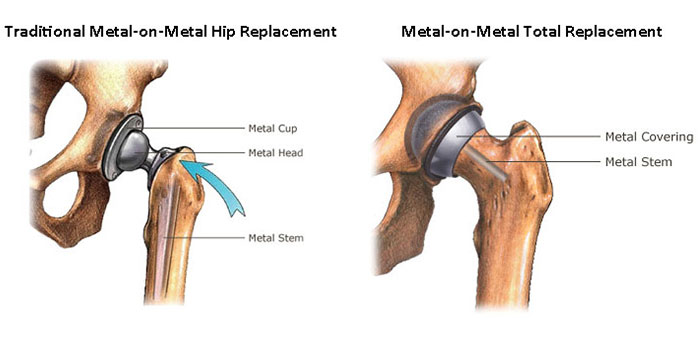What are Metal-On-Metal (MoM) Implants?
Metal-on-Metal total hip replacement implant systems consist of a metal ball (femoral head), a metal femoral stem in the thighbone, and a metal cup in the hip bone (Acetabular Component). Metal-on-Metal implants are usually recommended for younger and more active patients, mainly because they are supposed to be more durable and last longer than other materials, i.e., plastic or ceramic. metal-on-metal hip implants are made of a cobalt-chromium alloy.
**We are no longer accepting cases for this defective medical device
The two types of MoM hip systems are Traditional Total Hip Replacement Implant and Total Resurfacing Hip Implant.

According to the FDA, metal-on-metal hip implants are known to have adverse events, including infection and joint dislocation. MoM implants include Johnson & Johnson’s DePuy Pinnacle, DePuy ASR, and Stryker Orthopedics Rejuvenate among others.
While hip joint replacement surgery is often an effective way to regain mobility following a serious sports injury or other accidents, many have been negatively affected by the recent recall of DePuy Orthopedics’, a division of Johnson & Johnson, metal ASR-Acetabular System hip joint implants.
Patients reported serious complications of defective metal-on-metal implants:
- Unexplained hip pain and swelling long after the initial surgery
- Stiffness of the joint
- Increased difficulty in mobility
- Infection to surrounding muscle and bone tissues due to grinding metal on metal
- Hip bone fractures
- Blood poisoning due to metal shards entering the bloodstream (Metallosis)
Nearly 13 percent of patients required expensive revision surgery within five years, as opposed to the 20 years the product was marketed to operate. This percentage led Johnson & Johnson to recall approximately 93,000 hip implants thought to be defective.
Causes of Hip Implant Failures:
Orthopedic surgeons have reported that the design of a metal-on-metal implant makes it difficult to place it at the proper angle for successful long-term wear. This improper positioning can lead to failure.
Once the metal-on-metal implant begins to fail, the metal femoral head may begin to rub against the metal acetabular cup. This design flaw allows metal parts to rub against each other and may be releasing metal ions to the surrounding soft tissue, which then react with inflammation and swelling, leading to pain. Also, these abnormally high metal ions keep the cup from securely bonding to the natural hip, leading to instability and even dislocation. The medical community is expressing concern over severe tissue injury and bone damage resulting from metal-on-metal hip replacements.
According to a report in the New York Times, approximately one third of 250,000 hip replacements done annually in the US involve metal on metal implants.
Contact Miller Weisbrod Olesky
We represent individuals nationwide who have suffered adverse effects due to defective metal-on-metal hip implants. If you or a loved one has suffered due to a defective metal-on-metal hip implant, we can help you pursue just compensation for your medical expenses, lost wages, and the pain and suffering you have endured. We invite you to call our main offices in Dallas at 214.987.0005 to schedule a free consultation with an experienced attorney who will give you honest answers to your questions and a free case evaluation.
If you are calling from outside the DFW Metroplex, please call our toll-free line at 888.987.0005. You may also contact us by e-mail to schedule an appointment or request additional information.

